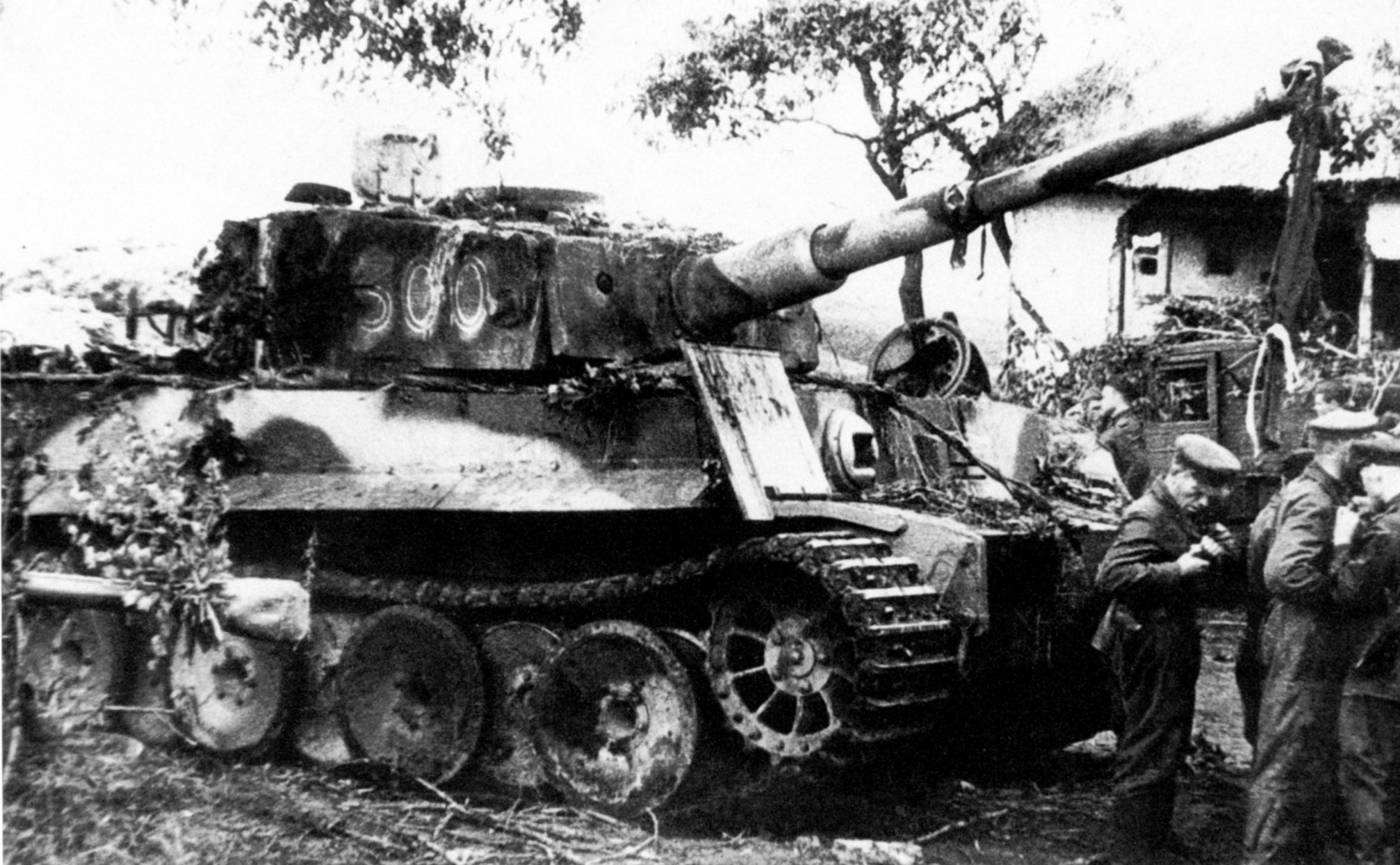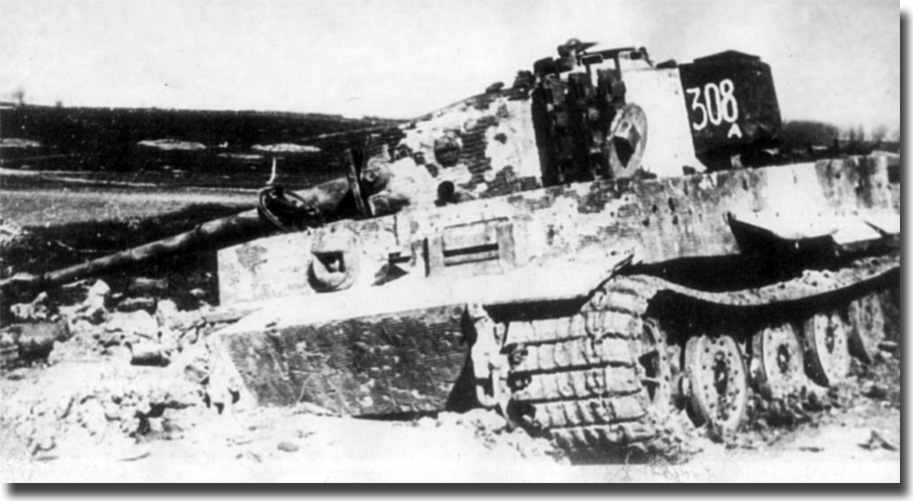| “Tiger, Tiger, Burning Bright”
By David Hughes
February 2022
 I was looking at the armour values for the Churchill tank in Panzer Grenadier, but was distracted by the Tiger, more accurately as to why British tankers feared the Tiger I tank so much. One puzzle is that this is largely limited to the Normandy campaign. When the Tiger I was first encountered in Tunisia, there was little concern, let alone hysteria. They were met, dodged, shot up, evaluated and shipped off to England for testing. Yet all that was available to handle them was the 6-pounder mounted on Churchill and some Crusader and Valentine tanks, the towed 17-pounder, still with its basic APC ammunition and the ubiquitous 75mm. I was looking at the armour values for the Churchill tank in Panzer Grenadier, but was distracted by the Tiger, more accurately as to why British tankers feared the Tiger I tank so much. One puzzle is that this is largely limited to the Normandy campaign. When the Tiger I was first encountered in Tunisia, there was little concern, let alone hysteria. They were met, dodged, shot up, evaluated and shipped off to England for testing. Yet all that was available to handle them was the 6-pounder mounted on Churchill and some Crusader and Valentine tanks, the towed 17-pounder, still with its basic APC ammunition and the ubiquitous 75mm.
But Normandy was a different story. Whether they were veterans of the 7th Armoured or largely inexperienced men of the Guards and 11th Armoured Divisions, British tank crews quickly developed a serious phobia over the Tiger. The Mark IV was easy, as even the feeble 75mm had a chance, while the Panther, despite its sleek design and deadly gun could be handled. In the early battles between the Canadians and the Hitler Youth it was clear that victory usually went to the tank or anti-tank gun that spotted the enemy first. The Germans did well on the defence, but found any tactical attacks to be expensive, with heavy losses to both panzer grenadiers and tanks. The reason was simple. When attacking, Panther tanks habitually exposed their tender flanks to Allied infantry, anti-tank guns and tanks. While the front had 100mm of superbly sloped armour, the side had 45mm of vertical plate. The result was instant penetration and a perfect demonstration of the accuracy of the Panzer Grenadier modification of +2 for multiple hex anti-tank fire, simulating side or rear shots.

The Tiger could be declawed, but it wasn't easy.
So what is so different about the Tiger I? Its frontal armour was inferior to the Panther, equal in thickness, but almost vertical, yet the British (and by extension the Americans) found it much tougher to kill. Fixing the Tiger in place by deploying a couple of Sherman tanks in front and then sending another to the flank almost invariably failed, costing tank crews their lives. Even the all-conquering 17-pounder had a problem, despite its theoretical ability to penetrate. For in Normandy the Tiger would usually sit behind a hedge or a slight rise, leaving only its turret in sight. Although this is listed as having the same (100mm) of armour as the nose, what is forgotten is that it was mostly covered by another 100mm of armour in the shape of the gun mantle. Gunners were therefore reduced to hearing such fanciful advice as "bounce it off the bottom of the gun so that it misses the mantlet!"

This Tiger will terrorize no more.
The real Tiger trick lies in the thickness of its flank and rear armour. As far as I know (doubtless I will be forcefully advised to the contrary) it is unique among the main tank types in having flank and rear armour that was almost as tough as its front armour. In fact under combat conditions this 80mm flank equalled its 100mm front, as shots angling in from the frontal arc faced the same effect as sloped armour. A hit might muck up the Tiger’s suspension, but the complex and costly overlapping road wheels were designed to compensate for this. To make matters worse, as any tanker will tell you, even small folds in the ground will both protect and hide the lower side of a tank. The only sure way of knocking out a defending Tiger was to move a 17-pounder (essentially a Firefly or an Achilles) until it had a clear line of sight to its lower flank or rear. However, when it was attacking, unless it lay well back and let lesser tanks move ahead, the Tiger was vulnerable. Infamous SS tanker Michael Wittman, for example, after his celebrated attack entered the town of Villers-Bocage and allowed his own Tiger and a couple of others to be knocked out by 6-pounder guns firing into their flank.
So this time my suggestion does not involve nice new counters, but rather an anti-tank die-roll modifier that needs to be modified. In applicable scenarios, especially when self-designed, ignore (or just reduce to +1) the modifier for being attacked through two or more non-adjacent hexes, when the target is a Tiger I.

Not even the Tiger II is invulnerable.
Notice that I do not say Tiger — none of this applies to a Tiger II, its front armour is now 180mm, but the side armour remains at 80mm. Finally coming back to the start, which was why the Tiger was not considered a threat in Tunisia. It was attacking in small numbers, it was not closely supported by friendly tanks and infantry and the terrain (seemingly flat, but with hidden depressions) turned out to be eminently suitable for getting close to its rear, where the 80mm armour was weakened by engine attachments.
You can order Elsenborn Ridge (Playbook edition) right here.
You can order Liberation 1944 (Playbook edition) right here.
Please allow an extra three weeks for delivery.
Sign up for our newsletter right here. Your info will never be sold or transferred; we'll just use it to update you on new games and new offers.
Want to keep Daily Content free of third-party ads? You can send us some love (and cash) through this link right here.
|
